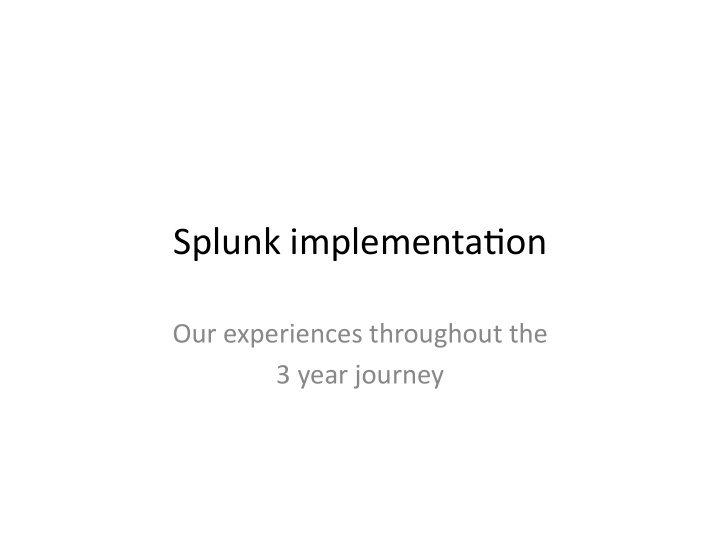



Splunk implementa-on Our experiences throughout the 3 year journey
About us • Harvard University – University Network Services Group – Serving over 2500 faculty and more than 18,000 students • Jim Donn Management Systems – Architect and implement Management solu-ons – Deliver fault no-fica-ons – Previously with HSBC – 13 years in IT from NOC ‐> Sr. Engineer • Tim Hartmann Systems Administrator – Architect and implement Authen-ca-on solu-ons – Troubleshoot various server related issues – Previously with another division within the University – 11 Years in IT from Help Desk ‐> Sr. Engineer
Our Interests • Share our experiences with others • Collabora-ng with like minded people • Discuss strategies to tackle common issues • Share solu-ons / code • Endorse community ac-vity!
Day 0 • Network and Systems team have very similar needs – centralized logging. • Teams belong to the same department, but historically act independently. • 2 independent Syslog‐NG implementa-ons. • Jim and Tim break the mold and talk to each other!
Network Management Systems Drivers • New tools must scale with the rebuild of Enterprise Network Management Systems • Syslog needs: – Syslog aggrega-on – Reliable event forwarding – Easy to use web interface – Centralized log viewer – Correla-on and aler-ng engine*
Systems Team Drivers • Need to track down and resolve issues faster • Syslog needs: – Centralized logging – Web based search viewer – Role based access to logs – Aler-ng – Repor-ng – Trend Analysis
Evalua-on • Tim leads Splunk evalua-on, sets up server – Simple installa-on • Tim and Jim point Syslog‐NG envs at Splunk • Develop User Roles strategies – Net Eng, NOC, Security, and Server teams • Develop data separa-on strategies (KISS) – Host names – Sourcetypes – Indexes
Installa-on stats • 400 Linux, Solaris, and Windows servers • 700 Switches and Routers • 2300 Wireless Access Points • TACACS+ authen-ca-on logs • VPN access logs • DNS and DHCP logs • 50 registered Splunk users, half are regular users
Phase 1 Hardware and Strategies What it runs on Strategies • RHEL 5 – 64 bit • Two of everything • Commodity HW • Fast disk • 15k local disk • Wherever possible we made our configura-ons – RAID 5 1.6T independent of other • 2 x 4 Core Processors services (SAN/NAS) (3.00 GHz) • Simplicity keeps it • 16 GB RAM maintainable • Custom Yum Repo for sohware Deployment
Phase 1 – Basic syslog, “just get it in” • Very few agents • All UDP • Sourcetype based roles • Dual role servers (search & index) • Hot / Hot HA architecture • 1.6 Terabytes of useable disk each • Splunk v 3.x
Closer look at Syslog‐NG
Phase 2 – More logs! • Merge Syslog‐NG servers • Start to introduce more Splunk agents to grab difficult logs • Add more departments • Splunk integrated with event no-fica-on path – Replaces syslog adapter in EMC Smarts • Splunk v 3.x
Phase 3 – Agents and Indexes More and more Splunk agents • – Windows servers migrated TCP forwarding of syslogs • • Mul-ple indexes Index based roles – Faster searches – Replace Smarts DB with • Splunk Hardware is now available for Splunk – expansion Splunk begins to fill monitoring gaps, • acts as “glue” Splunk v 4.x • Apps now available – Free Unix & Windows Apps – – First round of developing our own
Snapshot aher implemen-ng more indexes
Splunk growth around the same -me • Organic growth with other departments • Steady growth of indexed data – Introduc-on of new indexes • Security mandate to have Splunk on all servers
Phase 4 Hardware and Strategies What new Indexers runs on Strategies • RHEL 5 – 64 bit Horizontal expansion • – Search Heads • Commodity HW Two of everything • • 15k Direct Anached Array – Keep the hardware specs close as possible – RAID 5 1 TB Fast disk • – Room for more drives – Use of Linux LVM to grow • 2 x 4 Core Processors addi-onal disk (3.00 GHz) Wherever possible we made our • configura-ons independent of • 12 GB RAM other services (SAN/NAS) • Custom Yum Repo for Simplicity keeps it maintainable • sohware Deployment
Phase 4 – Apps and Security Migrate unified aler-ng • Remove UDP everywhere possible • New Splunk Architecture! • Horizontal expansion (map reduce) – Search Heads – Scheduled search server – – Automated sync More disk! – Load balanced VIP? – Agents, agents, agents • Support for apps – – Custom inputs Scripted output – • Splunk Agent on Syslog‐NG Deployment Server •
Phase 4, v. 2 ‐ Apps • Same as v. 1 but… • Collapse Apps into Splunk infrastructure: – MRTG? – Syslog‐NG? – Splunk‐data‐gatherer hybrid? • Deployment Server: – Use Puppet – Use SVN
From a users perspec-ve Search heads have access to all indexers: Two of everything for automa-c redundancy
Home Brewed Splunk Apps / Usage • Xen server status • Replace legacy monitoring scripts • Transac-on based alerts for Linux and Windows • Scripted inputs provide visibility into Network device port status (CLI only data)
Future Apps • Security App? • Manager of Managers – Add Net‐SNMP trap receiver – Migrate most MRTG graphs (Non‐RRD) – Replace Cac- (RRD) – Trend all EMC Smarts / snmpoll data
Addi-onal info Contact info james_donn@harvard.edu -m_hartman@harvard.edu Community hnp://answers.splunk.com hnps://listserv.uconn.edu/cgi‐bin/wa?A0=SPLUNK‐L
Recommend
More recommend